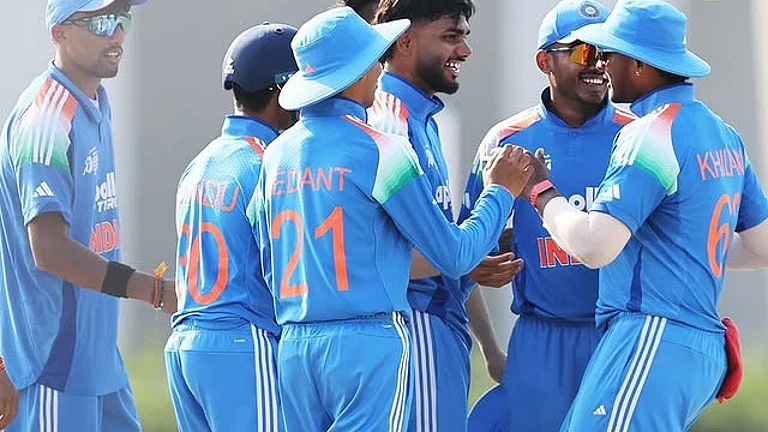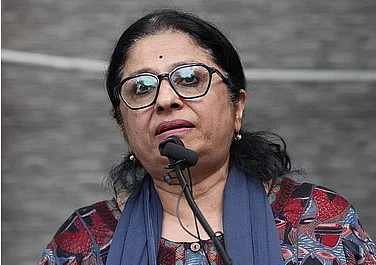From a distance, they appear like ancient rock dwellings nestled in the mountains. However, these rock houses are not as old as they seem. Just a few decades ago, people were living in these houses in the hamlet of Hundurman Brok. Now, these rock homes with low roofs, small doors, and one little window have been transformed into a museum village. And the three houses feature "Unlock Hundurman-Museum of Memories.”
It has a collection of shells, bullets, old shoes, clothes, letters from divided families, shrapnel, old army helmets and old household items, handicrafts used in the village, and also currency, apparently jointly issued by the governments of India and Pakistan.

The road to Hundurman Brok is blacktopped, and from the road, one can see the ancient Silk Route, also called the Skardu–Kargil Road, across the Suru River. Along the road, tourists stop at the Hundurman LoC viewpoint constructed by the tourism department of the Union Territory of Ladakh. From this point, visitors can get a view of the LoC. If visitors wish to have a clearer look, they are allowed to use a telescope with an installed lens.
A wooden board near the village Hundurman reads: "Unlock Hundurman (Museum of Memories), an abandoned pugri settlement in Kargil located at the LoC, came under India post the 1971 India-Pakistan conflict. The rediscovery of the settlement in the form of artefacts and memories demystifies its dominant narrative as a war-ridden village."

The board also reveals that the project is a collaboration between Roots Collective (a non-profit organisation based in Kargil) and SWS CEPT University, Ahmedabad, to preserve the history, culture, and memories of the border settlement through oral narratives and recovered artefacts.
Once you reach the settlement after a long descent from the road, another board reminds you that a few years ago, special permission was required from the Indian army to visit the abandoned village. But now, that practice has been discontinued.
The museum is managed by Illyas Ansari, who is 35 years old, and his younger brother, Fida Ali. While Ansari is a graphic designer, Ali works with the Army as a porter. With a welcoming smile, Ansari asks you to lower your head when you enter the houses and the museum. “You shouldn’t hurt your head,” he says. The museum's entrance is secured with a wooden key and wooden lock. Ansari shows you the long wooden key to remind you of times gone by.

Once you step inside the museum, darkness surrounds you, but when the lights are switched on, you can see old utensils used by the residents, shells from the 1971 and Kargil wars collected by locals, precious stones found in the region, butter tins made in Pakistan by the Pakistani military, and Ibex horns in a small room.
Inside the room, a plain paper provides the history of the village. It says: “In the 24 years that Hundurman was under Pakistani occupation (1947-71), life was very difficult for the people. There was no development in terms of infrastructure, communication, and health. Children had to walk miles to school, and many people lost their lives while being carried to the nearest hospital.”
“When the India-Pakistan war erupted in 1971, people took to the caves for shelter and witnessed the destruction from close quarters. Few families fled to the next village in Pakistan, while most families stayed back and helped the Indian Army with food and other supplies. The families that took refuge in Pakistan communicated with their relatives in Hundurman through letters until a few years ago. Today, they can stay connected through modern means of communication. The mutually beneficial relationship between the locals of Hundurman and the Indian army continues to flourish even today. Unlike other border settlements, the army and the locals rely on each other, especially in times of need, for instance, during the floods in 2014. Development and modernisation of the settlement is fairly recent and can be attributed to the advent of the memorable road in 2005 and electricity in 2006.”
Ansari says in the past few decades, all the families residing in Hundurman Brok have relocated to a higher area around one km uphill. He says the reasons for shifting from the place to the uphill were the scarcity of water and the fear of avalanches during the winter season. The new settlement is referred to as Hunderman.

According to Ansari, several centuries ago, families from the Poen village of Kargil migrated to Brok, where they established stone dwellings.
Ansari explains the importance of this village and its associated museum within the broader context of Ladakh's rich history. During a time when the majority of the population, particularly in rural areas, relied heavily on livestock, they would routinely lead their flocks to pastures for grazing during the winter months, and this was the preferred place.
Ansari says originally referred to as Hundermo, the village underwent a name change to Hundurman in honour of Major Maan Bahadur of the Indian Army, who played a major role in repelling Pakistan's forces from the territory in 1971. The village existed as a no-man's land for three months following the 1971 India-Pak, subsequently becoming a part of India once the Indian Army established control, says Ansari.
In 2005, the construction of the macadamized road up to the village was started, and by 2011, the road was completed, making it easy for the villagers to travel to the district headquarters in Kargil. This brought more education avenues for the villagers. But at the same time, the crises of climate change and global warming hit the village, and the villagers abandoned Brok houses, which they were used for livestock, turning it into a ghost village.
Ansari says in 2011, an architect from Ahmedabad brought by the Roots Collective (a non-profit organisation based in Kargil) visited the village and was surprised to see abandoned houses. As he entered the houses, he found that each house had two levels. He was amazed by the architecture of the structures as the lower portion was used for housing cattle, while the upper level served as a home for the villagers. Narrow pathways connected these homes to one another and to the terraced fields. The lowest level of the home featured a local dry-pit toilet. The homes were constructed using stone, earth, and wood from willow and poplar trees, with lighter materials like willow mesh and clay plaster.
According to Ansari, the tourist got in touch with Ajaz Hussain Munshi, a well-known museum curator of Kargil, who started working on the Hundurman Brok as a heritage site.
Already, the village had ample material in terms of shells, bullets, old guns from the 1971 war, and helmets. They placed them in a small three-room museum, now known as the Museum of Memories. They also found within the village letters written by divided families to each other.
One of the letters, written on April 29, 1985, is from a brother whose sister was in the village.
The letter is in Urdu: “With God's grace, I hope you are in the best of health. With your grace and well wishes, everything here is running smoothly. It gives me immense pleasure to know that you are living a joyous life. Everything is fine at home, and there is no need to worry about the situation over here. I hope everything is fine there. I sent a present for you with Mohammed Abdullah. Have you received it? Please write back to me about it. How is everything there? Please write to me about the family and your kids. I have sent many letters to everyone there, but I have not received any replies. If I have done anything wrong, I would like to beg for forgiveness from the bottom of my heart. What else is there to talk about? Please convey my regards to our family members, Asgar Khathi's family, Haji Akbar's family, Bhai Mohammed Ali Abdullah Rahim's family, Mohammed Ali's family, and Ibrahim Haider's family. Please convey my affection to both the young and the elders. Kindly write back to me soon; I will be waiting for your reply.” The caption of the letter is: A letter written in 1985 by a brother living in Brolmol who got separated from his sister living in Hundurman during the war of 1971.
“The village has many tragedies. Every house has divided families. When in 1971, the village became part of India, every house had relations in Brolmo and Bilargu and other villages which are now part of Pakistan. My own mother’s brothers were not at home in 1971. They remained on that side. A few years ago, when my maternal uncle came to see us, my mother couldn’t utter a word. She was in shock,” Ansari says.

Ansari is more interested in making the village famous through the museum. He says a decade ago, Hundurman was a fertile village, and greenery was all around. Now it is gone. The villagers say snowfall has dwindled, and from six feet of snow, only six inches accumulate in the winter. In these years, many filmmakers have visited the village, and Ansari is hopeful that a documentary on the Museum and the villagers will come up internationally, bringing the Museum village to the world tourist map.
“We don’t want to earn anything out of the Museum, but we want tourists to visit the village to see how people were living in the region only a few decades ago,” he says.


























